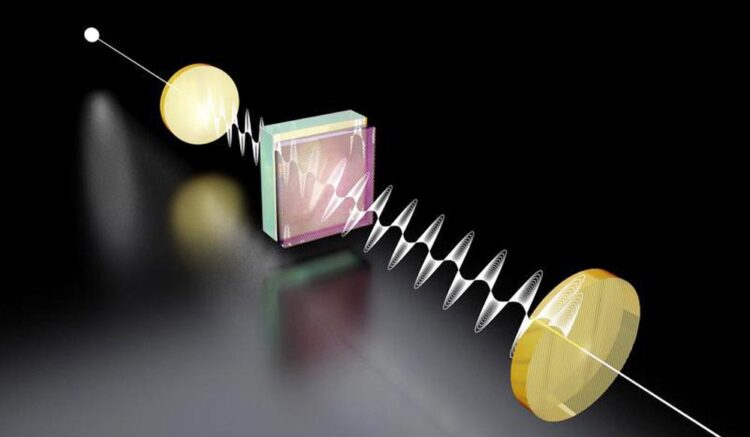A Quantum of an Angle

A light source (left) sends a beam of light through a special material, which changes the direction of polarization - by an angle that is given by the fine structure constant.
© Graphik: Tatiana Lysenko / TU Wien
The fine structure constant is one of the most important natural constants of all. At TU Wien, a remarkable way of measuring it has been found – it shows up as a rotation angle.
One over 137 – this is one of the most important numbers in physics. It is the approximate value of the so-called fine structure constant – a physical quantity that is of outstanding importance in atomic and particle physics.
There are many ways to measure the fine structure constant – usually it is measured indirectly, by measuring other physical quantities and using them to calculate the fine structure constant. At TU Wien, however, an experiment has now been performed, in which the fine structure constant itself can be directly measured – as an angle.
1/137 – the secret code of the universe
The fine structure constant describes the strength of the electromagnetic interaction. It indicates how strongly charged particles such as electrons react to electromagnetic fields. If the fine structure constant had a different value, our universe would look completely different – atoms would have a different size, so all chemistry would work differently, and nuclear fusion in the stars would be completely different as well.
A much-discussed question is whether the fine structure constant is actually constant, or whether it could possibly have changed its value a little over billions of years.
Direct measurements instead of calculations
“Most important physical constants have a specific unit – for example, the speed of light, which can be given in the unit of meters per second,” says Prof. Andrei Pimenov from the Institute of Solid State Physics at TU Wien. “It’s different with the fine structure constant. It has no unit, it is simply a number – it is dimensionless.”
But usually, when the fine structure is measured, various quantities with different physical units have to be measured, and then the value of the fine structure constant is inferred from these results. “In our experiment, on the other hand, the fine structure constant itself becomes directly visible,” says Andrei Pimenov.
A thin film that rotates the light
A laser beam is polarised linearly – the light oscillates exactly in vertical direction. Then the beam hits a layer of a special material that is only a few nanometres thick. This material has the property of changing the polarisation direction of the light. “’A material rotating the polarisation of a laser beam is, by itself, nothing unusual. Different materials can do this; the thicker the material layer, the more the polarisation of the laser is rotated. But we are dealing with a completely different effect here,” explains Andrei Pimenov. “In our case, the polarisation is not rotated continuously – it jumps.”
When passing through the thin film, the polarisation direction of the light performs a quantum jump. After passing through, the light wave oscillates in a different direction than before. And when the size of this jump is calculated, an astonishing result appears: the quantum of this angular change is exactly the fine structure constant.
“We thus have direct access to something quite unusual: a quantum of rotation,” says Andrei Pimenov. “The fine structure constant becomes immediately visible as an angle.”
Original publication
Contact
Prof. Andrei Pimenov
Institute for Solid State Physics
TU Wien
Wiedner Hauptstraße 8-10, 1040 Vienna
+43 1 58801 13723
andrei.pimenov@tuwien.ac.at
https://www.tuwien.at/en/tu-wien/news/news-articles/news/ein-quant-als-winkel
Media Contact
All latest news from the category: Physics and Astronomy
This area deals with the fundamental laws and building blocks of nature and how they interact, the properties and the behavior of matter, and research into space and time and their structures.
innovations-report provides in-depth reports and articles on subjects such as astrophysics, laser technologies, nuclear, quantum, particle and solid-state physics, nanotechnologies, planetary research and findings (Mars, Venus) and developments related to the Hubble Telescope.
Newest articles

Innovative 3D printed scaffolds offer new hope for bone healing
Researchers at the Institute for Bioengineering of Catalonia have developed novel 3D printed PLA-CaP scaffolds that promote blood vessel formation, ensuring better healing and regeneration of bone tissue. Bone is…

The surprising role of gut infection in Alzheimer’s disease
ASU- and Banner Alzheimer’s Institute-led study implicates link between a common virus and the disease, which travels from the gut to the brain and may be a target for antiviral…

Molecular gardening: New enzymes discovered for protein modification pruning
How deubiquitinases USP53 and USP54 cleave long polyubiquitin chains and how the former is linked to liver disease in children. Deubiquitinases (DUBs) are enzymes used by cells to trim protein…


